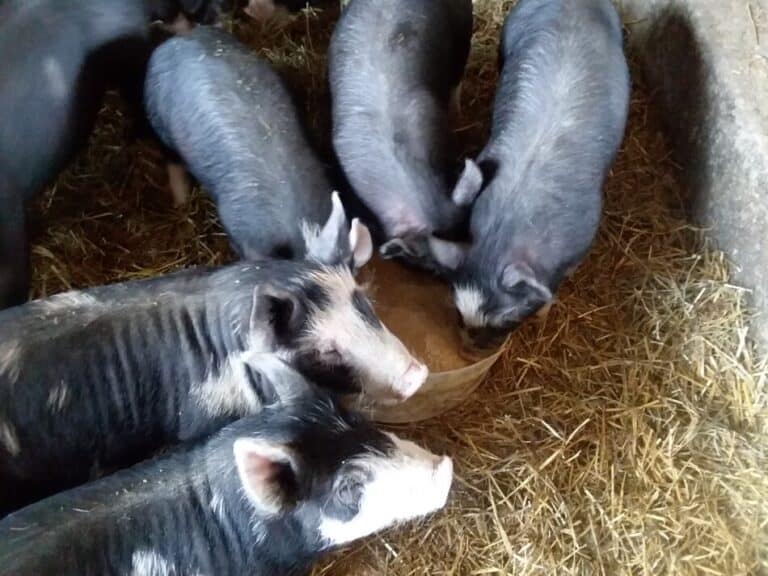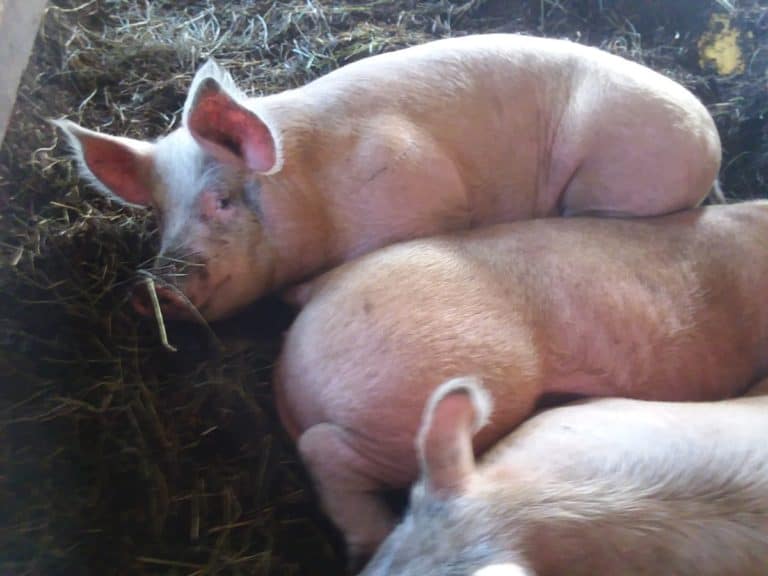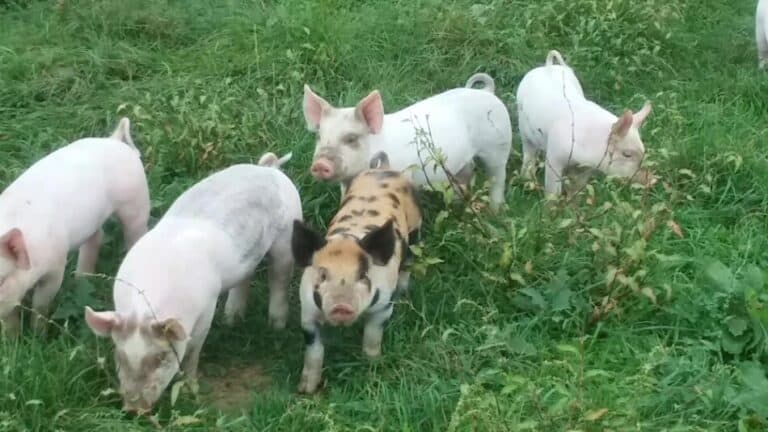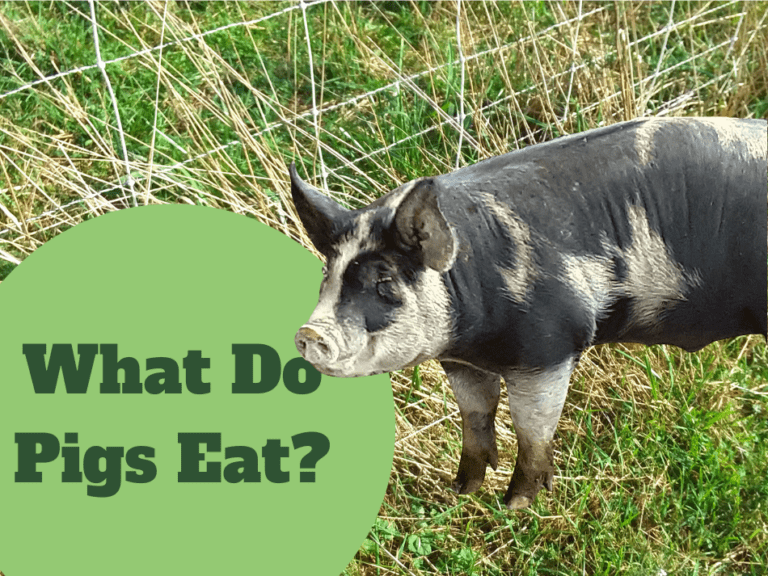7 Tips To Keep Feeder Pigs In The Fence

Thinking about raising a few feeder pigs but wondering how to keep them in the fence? No worries, you’ve got a few fencing options and it’s easier than you’d think!
Feeder pigs need a solid hog panel and T post fence when they are small, transitioning to electric (if wanted) when the pigs are bigger.
Keeping your feeder pigs in their fence is pretty easy, as long as you match the fence to the size of your pigs and start them off in a hog panel pen.
Pros And Cons Of Raising Pigs gives you a look at the good and the not so good of raising pigs.
Start feeder pigs on a T post and hog panel fence
Whether you want to keep your feeder pigs in a roomy pen or keep them on pasture, you’ll still need to start them off in a solid pen.
How Much Space Do My Pigs Need will give you a possible pen design and space requirements for your feeder pigs.
Feeder pigs in a T post and hog panel pen in your yard
If you are planning to raise your pigs in a pen the whole time, make sure they have plenty of room to run around and are able to interact with their environment by rooting.
Plan to move the pen a few times over the course of raising your pigs, they’ll need a new spot unless you have really hard or dry soil.
Feeder pigs of any size up to market hogs (butchering size pigs) can be kept in hog panel pens.
You’ll need to monitor the pen since as the pigs get bigger, they also get stronger and more capable.
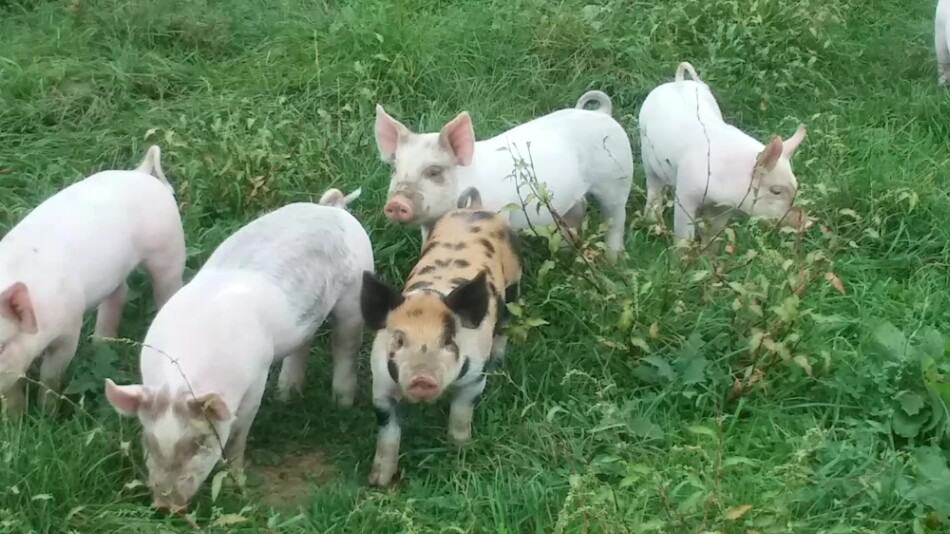
The T posts may need to be redriven and the panels repositioned a few times before your feeder pigs are finished growing.
As long as you are willing to watch the fence, hog panels will work. If you feel the pigs will easily dig out, consider transitioning them to electric.
Feeder pigs can be raised inside a shed or barn
Give your feeder pigs a roomy pen and plenty of bedding and they will be happy under roof.
As your pigs grow, they will need more space per pig. Keep in mind their final weights and size when you are picking out a pen location and size.
I keep my boar and two sows in a 25 x 25 ft pen and they have tons of room. These adult pigs weigh 400 pounds or so each, so an area this size would be super for 2-3 feeder pigs growing to market size.
A smaller area can be used with more bedding. If you can smell manure, you are not using enough bedding.
We use pigs inside barn areas that are hard to clean out, like where we keep the sheep in the winter. This keeps the pigs happy and gives them something to do.
They naturally will root up the old bedding in areas we can’t reach with the tractor. This rooting saves me some pitchfork time and keeps them busy!
Do you have an area of your yard or garden that could use some pig power?
How Much Freezer Space For Your Pig? shows you how to figure up the space you’ll need for your pork, even if you still have stuff in the freezer!
Pastured pigs need a solid pen at first
When you first get your feeder pigs, it can be tempting to just turn them right out into the pasture. They are supposed to be eating grass and they’re used to a fence right?
Maybe. If the farm your piglets came from had them on electric, this should be easy, but you’ll still want to put them in a hog panel pen first!
Why worry about it? It will save you some chasing, feeder pigs are fast!
Turn them out into a solid pen for the first day or two, to give them some time to get used to you and their new home.
Once they come up to eat and seem relaxed, now you can let them out to a small, well marked, electrically fenced paddock and see how they do.
If your piglets have never seen electric, you’ll need to put in a bit more work.
Start all piglets in a hog panel pen
Start them off in a hog panel and T post pen. If your piglets are under 50 pounds or so, plan on them staying inside this panel type pen for a few weeks until they grow a bit bigger.
This means you may need to bed down or move the hog panel pen a few times before you can start training them to electric.
If you purchased bigger feeder pigs, you may only need to keep them in the panel pen for a few days. For the smaller pigs, keep them in it longer.
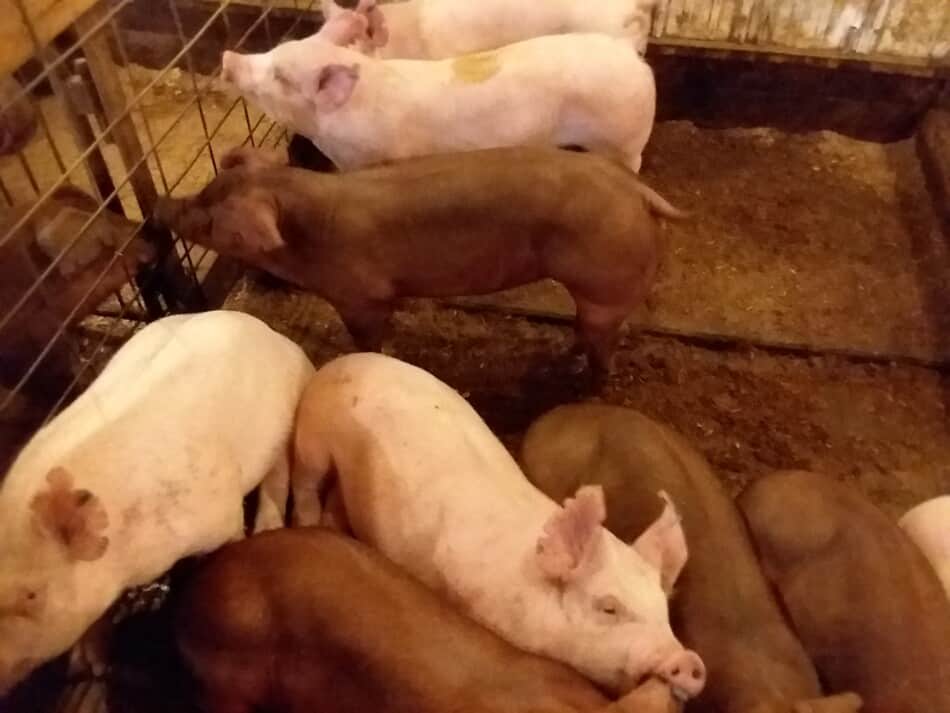
Check the feeder pig fence daily
This is probably the top tip, check the fence!
Feeder pigs are going to be spending their day exploring the area and rooting around.
It doesn’t take too much rooting to plunk a chunk of dirt over onto the wire, now the fence is grounding out!
The good news here is you can see this coming and either move the fence line or raise up the wire in that area to keep the fence wire hot.
The fix is easy, the hard part is having the discipline to do the checks!
Pigs can move objects into the fence
Another thing you may not have considered is that anything the pigs can move can be shoved over or tipped onto the fence.
Feeders, empty waterers, big bales of hay that you put in for shelter or fun, whatever. If they can move it, it can end up grounding out the fence.
Keep the feeder and waterers full so they will be kept in place with their own weight.
Anything else in the pen that the pigs can move should be monitored or taken out before it shorts out the fence.
Non electric pig fences need checked
If you have decided to keep your pigs on hog panel fencing, you’ll still need to check the fence!
Your porkers will be rooting around, this is what healthy pigs do.
Look around to see if they are working on digging out under the fence or just loosing up a section enough to shinny underneath.
Younger pigs need more of a fence
Younger piglets need more of a solid fence than older pigs. This seems to be backwards, but it’s more of a visual thing than a physical containment issue.
Smaller pigs will skitter under/through a fence quickly and seem to get less of a shock when doing so!
Keep your piglets in a solid (non electric) fence until you have a few hours to spend watching them to make sure they respect electric. Or don’t be surprised when they get out!
This hard to fence with electric phase will pass quickly, since piglets are such fast growers.
The great news is that larger sized piglets (80+ pounds) are pretty easy to fence (once trained).

You’ll need to train piglets to the electric fence
Even if you buy piglets that have been on electric fence before, take this step seriously.
There is a difference between piglets knowing about the fence and respecting it as a boundary and piglets roaming around with their mom and being too short to hit the fence when they run under it!
As mentioned before, start your piglets off in a hog panel and T post pen. Plan on them staying here for a few days, longer if they are small.
Your first step in training the electric is to run a strand of hot (meaning has power) fencing across one edge of the piglets pen.
This can be more challenging than it sounds, you don’t want any part of the hot wire touching the panel!
Give the pigs a few days to get used to the hot wire. You’ll know they understand it when you don’t hear any more squealing!
Each pig will eventually get curious enough to touch the wire with their nose, obviously getting quite the shock.
If you have 3 pigs, you’ll hear 3 squeals. This is all it takes, now they are watching for the wire and avoiding it.
Keep the piglets in this pen for a day or so after the experimental fence touching is over.
Once you haven’t heard any fence related squeals for a day or so, you’re piglets are ready to be on a small electrically fenced pasture.
Make a well marked paddock with at least two strands of electric. Penn State Extension suggests wires at 10 and 18 inches for growing pigs.
If your pigs were weaned early, these wires (10 and 18 inches) will be too high, simply because your pigs are shorter since they are young.
Start with a lower strand height or keep them in a hog panel pen until they grow a bit and will be more easily fenced.
When your piglets get bigger, you can drop back to one strand of electric if you want. At first go will at least two.
For visibility alone, a poly braid type electric fence strand will work better than a metal wire.
Metal wire will work fine, it’s just a bit harder for the pigs to see than poly braid.
Run the strands at a bit lower than the piglets nose height and one strand at their eye level.
If you are not sure what height to use, lower is better than higher. Piglets will go under fences to escape much more frequently than they go over fences.
Once the piglets understand where the fence is they will respect it (if you have trained them to electric).
Go slowly at first and give them time to get used to the new fence location anytime you move them to a new grazing area.
Test an electric pig fence everyday
If you are new to electric fencing, you may not realize that you need to test the fence, preferably daily.
Testing your fence gives you a quick and easy way to know that your fence is running well or that you have a problem and need to look around to fix it.
Generally, problems with your fence not having enough power are easy to fix, once you find them!
The main culprits of low to no power in your fence are going to be:
- vegetation touching the fence
- fence touching metal
- extremely dry field conditions
Dealing with the vegetation is easy, stomp it down or cut it back.
If your fence is touching metal, you should be able to hear it shocking out. In the dark, you’ll be able to see the spark. (Don’t ask me how I know!)
Often times, the fence is shocking out because an insulator pivoted on a metal post or the pigs pushed something that is now actually touching the wire.
If the insulator is turning on the post, consider adjusting the fence line so that you have a straighter run from post to post.
Otherwise, the fence will constantly be trying to pull the insulator to the side.
Sadly, when it is really dry out (I’m talking near drought like dry) your fence will not shock as well as it should, even if you have it set up properly.
Why? The way your pigs get shocked when they touch the fence is that the charge in the fence is looking to escape to the ground.
This is why the fence will shock a metal post, the charge wants to leave the wire.
When it is really dry out, there is not enough water in the soil to make it conductive.
It has to be easier for the charge to shock the pig by going through the pig to the ground than for the charge to continue through the wire.
In extremely dry conditions, shocking your pig has more resistance than continuing through the wire.
Since the charge goes where it has the least resistance, your fence won’t be doing much for you. Shocking the pig is not easier than staying in the wire (yikes!) so your porkers can get out!
What can you do to help the fence perform better?
Make sure there is nothing touching the fence and water the ground rod for your fencer (a tip from Greg Judy).
Have a perimeter and a division fence for pigs on electric
A good policy is to have a perimeter fence and then divide the pasture up into smaller sections with division fences.
Make the perimeter a bit more stout than your internal fences. For example, have a 3 strand perimeter and a one or two strand paddock division wire.
This way if the pigs do “escape” they are still in the perimeter fence and not harassing the neighbors!
A perimeter fence is not mandatory. If you are comfortable with just the paddock fence, that’s fine.
Move the pigs before they run out of grazing
A final tip to keeping your pigs happy is to give them something to do! If your porkers have eaten most of the interesting stuff in their paddock, move them.
Since pigs enjoy adventurous eating so much, they are willing to push the fence a bit to get more interesting snacks.
Keep things interesting in their pen or paddock and they are more likely to leave the fence alone.
